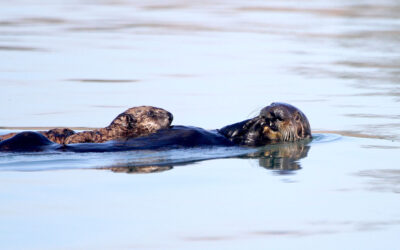Climate change-induced marine heatwaves are severely impacting reef-building corals, crucial species whose limestone skeletons form coral reef around the globe. These colorful and charismatic species are particularly sensitive to temperature changes, and as the ocean warms, they are facing intense selective pressure and mass mortalities.
Can coral evolution keep pace with ocean warming? Maybe, says coral reef ecologist Liam Lachs from the University of Newcastle, UK. He believes that corals could adapt, but only if we significantly reduce carbon emissions.
Coral reefs are colonies of coral polyps — hundreds to hundreds of thousands of tiny, soft-bodied, sea-anemone-like creatures whose limestone external skeletons make up the familiar staghorns, plates and brain corals, and many more, found across the tropics.
Take the stunning reefs of the Republic of Palau, home to myriad marine species. This Micronesian archipelago lies north of Papua New Guinea, comprises 340 islands, islets, and coral atolls, and has been subjected to mass coral bleaching conditions three times since 1985 — in 1998, in 2010, and in 2017. The first caused catastrophic coral mortality, similar to the second, but 2017 brought little or no bleaching, says Lachs, although conditions were worse than in 1998.
Did this mean the corals were getting used to the heat? Were Lachs and his fellow researchers seeing adaptation through natural selection, in action?
To explore that question the researchers turned to Acropora, a common coral genus on Palauan reefs, known to contain the fastest-growing tropical corals. Although heat-sensitive, Acropora are increasingly driving resilience and reef recovery after heatwaves.
“As reef communities shift away from the long-lived corals and are replaced by Acropora, it becomes progressively more important to understand the eco-evolutionary processes in this key coral group,” said Luke Thomas of the Australian Institute of Marine Science, who was not involved with the study.
Gaining such insights will help us better understand the future of corals in a warming world — how they react, what their ecological limits are, and what part evolution will play.
What makes coral so sensitive?
Many corals, including Acropora and other major reef-building species, contain algae within their tissues. In fact, it is the algae that lends coral reefs their vibrant colours. The relationship is symbiotic — algae get protection, access to sunlight, and nutrients from coral waste products. Coral gain up to 90% of their nutritional needs from organic compounds produced by algal photosynthesis.
But at unusually high summer temperatures, the algae’s photosynthetic machinery breaks down, leaking damaging products into the coral hosts’ tissues. The coral kicks the algae out, leaving the polyps transparent or “bleached”. Polyps can still catch food but are in danger of starvation without algal photosynthesis.
Around Palau, that critical water temperature [for bleaching] is about 32.5oC, Lachs says. “Three to four weeks at that temperature triggers bleaching in the Acropora species,” he added. “And by ~4-5 weeks this progresses to mortality.” Dead coral tissue breaks down, leaving a bare coral skeleton and a dead reef.
But the researchers had seen what appeared to be adaptation and asked the question: how much of Acropora’s ability to adapt and survive bleaching hinged on the passing of heat tolerance genes from parents to offspring? Would we see coral adaptation contributing to reef resilience, keeping pace with the rate of ocean warming?
Real-time evolution
To find an answer, Lachs and his team developed and used an ecological-evolutionary metapopulation model called ‘ReefMod-PALAU, focussing on the very common Palauan Acropora species, the ‘corymbose’ Acropora digitifera, a major heat-sensitive reef-building coral, growing in shallow-water and shaped like bunch of flowers.
A. digitifera’s ecological, evolutionary and biological data was used in the model, including the first actual on-site measurements of the passing of heat tolerance from parent to offspring, and how that varied within the coral population.
ReefMod-PALAU was run with sixteen IPCC (International Panel on Climate Change) Global Climate Models (GCMs) under three future climate scenarios: (i) upper limit Paris Agreement with <2 °C global warming, (ii) moderate middle-of-the-road: ~ 2.7oC warming, and (iii) worst-case: ~ 4.4oC warming.
Changes in coral numbers with rising temperatures were modelled, with number of days above the 32.5oC bleaching threshold increasing alongside the selective pressure on the corals to resist bleaching.
The modelling showed that A digitifera would adapt to rising temperatures at only about 60% of the rate needed to cope with warming expected under moderate climate change by 2100, and about half that needed for the worst-case scenario. Current policies, as Lachs points out, have us heading for around 3oC of warming by the turn of the century.
Such warming means major reductions in coral cover by 2100, with local extinctions and ecosystem breakdown distinct possibilities. But natural selection will keep favouring heat-tolerant corals, even within these degraded populations, Lachs says, so there is still scope for populations to recover if enough resilient corals survive.
Thomas agrees, stating, “Eco-evolutionary models, such as the one developed by Lachs et al, that include the role of adaptation in coral reef responses to climate change, may offer more hope than previously thought, and establish clear warming thresholds at which coral adaptation can limit global decline.”
But successful adaptation also means minimising other stressors. Careful management of reef fisheries and water quality inputs has to run in parallel, Lachs says And helping evolution, through artificial breeding of corals for temperature tolerance, also has a role for high priority reefs, he adds. But “we must reduce greenhouse gas emissions to keep warming below the 2oC Paris Agreement limit.”
Reference: Liam Lachs, et al., Natural selection could determine whether Acropora corals persist under expected climate change, Science (2024). DOI: 10.1126/science.adl6480
Feature image: Ecologically important yet thermally sensitive corymbose Acropora corals, the focal coral taxon for this study. Credit: Liam Lachs

















